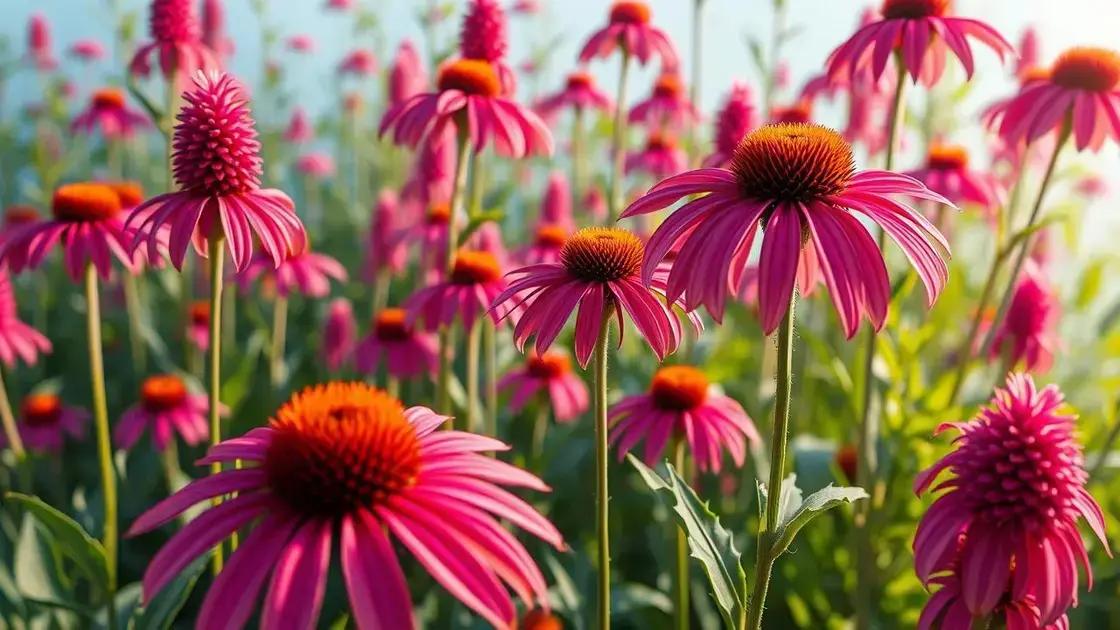How to Take Care of Echinacea Plants: 7 Essential Tips for Growth
How to take care of echinacea plants effectively can transform your garden into a vibrant ecosystem. With just a few insights on watering schedules, soil requirements, and optimal sunlight exposure, you can ensure your echinacea thrives. Discover how you can implement practical steps to nurture these beautiful flowering plants and make your garden bloom.
Table of Contents
ToggleWatering schedule for echinacea plants
Watering schedule for echinacea plants is vital for their health and flowering potential. To ensure these stunning blooms thrive, you must understand their specific watering needs throughout the growing season.
Here’s a comprehensive breakdown of an effective watering schedule:
Understanding echinacea’s watering needs
Echinacea plants, also known as coneflowers, prefer a moderate watering approach. They thrive in well-drained soil, and their deeply rooted system means they don’t require daily watering. Here are essential watering guidelines you should follow:
- Water deeply and less frequently, about once a week during dry spells.
- In cooler, wetter months, reduce watering frequency.
- Check the soil moisture at least a couple of inches below the surface before watering.
- Always aim to water early in the day to prevent fungal diseases.
Signs of over or under-watering
Recognizing the symptoms of over or under-watering can help you adjust your watering schedule effectively:
- Over-watering: Yellowing leaves, wilting, or root rot.
- Under-watering: Brown leaf edges, drooping, or stunted growth.
By paying close attention to these signs, you can modify your echinacea watering routine to foster healthy growth.
Practical tips for effective watering
- Use mulch around the base to retain moisture.
- Incorporate a rain gauge to measure rainfall in your garden.
- Consider using drip irrigation for consistent moisture levels.
- Observe your plants regularly for changes in appearance.
Implementing a tailored watering schedule can dramatically enhance the resilience and beauty of your echinacea plants. Remember, a thoughtful approach to watering helps in preventing common issues related to moisture retention.
For those interested in maximizing their gardening skills, exploring indoor gardening techniques can offer valuable insights applicable to outdoor horticulture as well.
Soil requirements to thrive

Soil requirements to thrive for echinacea plants are critical to their overall health and blooming potential. Understanding the type of soil they need can make a big difference in your gardening success.
To ensure these beautiful coneflowers flourish, consider the following soil specifications:
Ideal soil type for echinacea
Echinacea plants prefer well-draining soil that retains some moisture but doesn’t become soggy. Here are the key characteristics:
- Loose, sandy soil that allows for good drainage.
- Organic matter to improve soil structure and moisture retention.
- pH level between 6.0 and 7.5 for optimal nutrient uptake.
Benefits of the right soil mixture
Using the proper soil mix can provide numerous advantages:
- Encourages healthy root development.
- Prevents root rot by improving drainage.
- Enhances nutrient absorption.
- Reduces the risk of disease.
How to prepare soil for echinacea
Preparing the soil correctly involves a few straightforward steps:
- Amend the existing soil with compost or well-rotted manure.
- Test the pH level, adjusting it with lime or sulfur as needed.
- Add sand or perlite to enhance drainage if your soil is heavy.
By taking these steps, you’ll create an ideal environment for your echinacea plants to thrive.
If you’re keen to expand your gardening knowledge, exploring indoor gardening techniques can also provide valuable information applicable to outdoor soil preparation.
Sunlight exposure for optimal growth
Sunlight exposure for optimal growth is essential for the health of echinacea plants. Understanding how much light these flowers need can significantly impact their growth and blooming potential.
Echinacea plants thrive best with the right amount of sunlight. Here’s what you need to know:
Ideal sunlight conditions for echinacea
These beautiful perennials flourish when given plenty of sunlight. Here’s a breakdown of their requirements:
- Full sun exposure for at least 6 to 8 hours per day.
- Light shade in extremely hot climates to prevent wilting.
- Avoid heavily shaded locations that can stunt growth and flowering.
Benefits of proper sunlight exposure
Ensuring your echinacea plants receive adequate sunlight offers several advantages:
- Enhances photosynthesis, leading to vigorous growth.
- Encourages abundant flowering, providing color in your garden.
- Reduces the risk of common plant diseases associated with overcrowding and low light.
How to assess sunlight exposure
To determine if your plants are getting enough light, consider these tips:
- Monitor the sunlight hours in the planting area.
- Observe plant growth over time; seek out yellowing leaves as a sign of insufficient light.
- Adjust the positioning of your plants if they are not thriving.
By ensuring your echinacea receives the right amount of sunlight, you’ll promote a thriving garden filled with vibrant blooms.
If you want to learn more about gardening techniques, exploring indoor gardening techniques can provide valuable insights applicable to outdoor gardening as well.
In conclusion
Caring for echinacea plants is vital for cultivating a flourishing garden filled with vibrant blooms. By understanding their watering schedule, soil requirements, and sunlight exposure, you can create an optimal environment that promotes healthy growth and flowering. Remember to observe your plants closely and adjust your care as needed to ensure their happiness.
As you refine your gardening skills, don’t hesitate to explore more resources for your indoor and outdoor spaces. You can find tips on enhancing your indoor garden that may complement the care of your echinacea plants.

